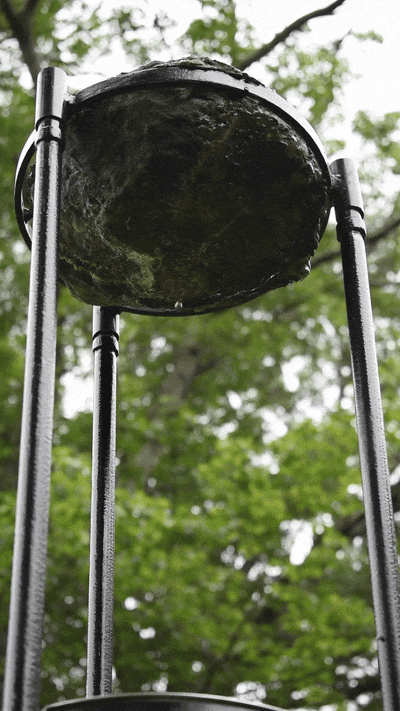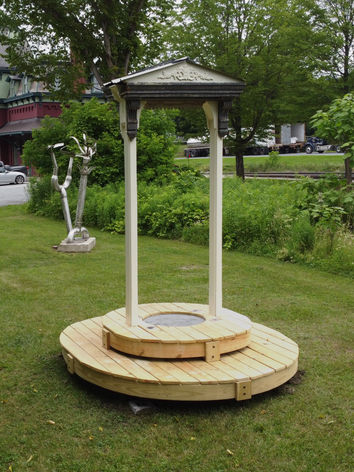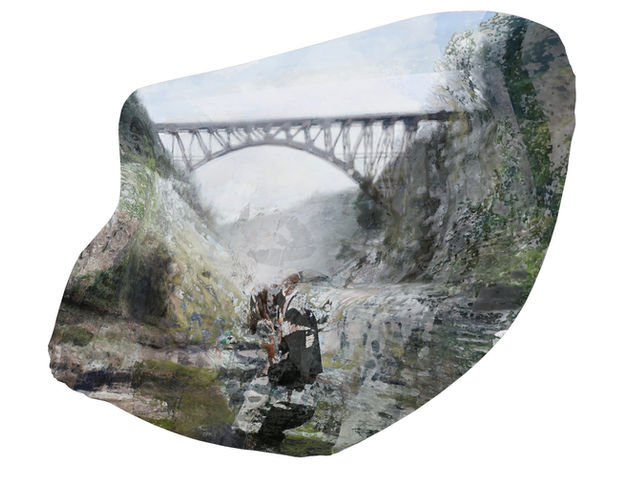Fusing Experiments, 2019-
Metamorphosis of various mineral and material bands within the earth is the result of extreme temperatures and pressures. Heat is one of the most important tools of humankind - with careful application of this force, we cook our food, keep our bodies comfortable in inhospitable climates, and create all glass, ceramic, metallic, and plastic materials with which we build our world. Heat is sometimes used as a source of electric power conversion, pumping current into our devices. Applying heat to various materials is a simple 1:1 procedure that calls to mind the plethora of possibilities within the materials surrounding us.
Fusing Experiments, 2019-
Metamorphosis of various mineral and material bands within the earth is the result of extreme temperatures and pressures. Heat is one of the most important tools of humankind - with careful application of this force, we cook our food, keep our bodies comfortable in inhospitable climates, and create all glass, ceramic, metallic, and plastic materials with which we build our world. Heat is sometimes used as a source of electric power conversion, pumping current into our devices. Applying heat to various materials is a simple 1:1 procedure that calls to mind the plethora of possibilities within the materials surrounding us.
Sam Horowitz
Precipitation Study #1 (Bringing the Mountain to Mohammed), 2024-.
10% limestone concrete, steel, fountain motor, tap water, hardware. Fountain stands 80" tall.
The crown of this fountain is composed of concrete with a 10% lime composition. Over time, the water pumped through this work will precipitate out the excess mineral, growing a stalactite from where it drips back into the reservoir. After the first three months of service, this work has developed .5mm stalactite nodules over its surface. This is many tens of times faster than is average for the natural creation of such dripstone formations, and I hope through some fine-tuning and control I can accelerate it even further. A biological growth appeared over the summer of 2025, hanging almost two centimeters from the crown, but dried during transportation to an exhibit.
First shown at Portal: Rockaway in NYC in 2024. Since then, it was exhibited at the Noyes Art Garage for the exhibit Academic Visions: Southern New Jersey University and College Art Professors Showcase in early 2025. It is currently in operation on Laurel Hill's grounds in Philadelphia as part of a show through Philadelphia Sculptors: Timeline, through October 18th, 2025.

Precipitation Study #2: Portal, 2025
Concrete with 10% limestone, salvaged architectural fragments, wood decking, steel, fountain pump, hardware. Work measures 8’ in diameter and 10’ tall. This photo was taken at the opening of this work at the North Bennington Outdoor Sculpture Show in North Bennington, Vermont, in June of 2025. Pictured is the artist speaking to visitors about the work.
A concrete casting of dentils hangs centered within the open doorway of this work. This casting was mixed with a 10% lime composition. A solar-powered fountain pump lifts water from a hidden basin up one of the legs, filling the casting at a slow trickle. This water overflows, running down the face of the concrete form and leaving mineralized records of its passage. Over time, the water pumped through this work will precipitate out more of the excess mineral, growing stalactites from where it drips back into the reservoir, and flowstone where it runs along it. This buildup, given enough time, should begin to echo and exaggerate the form of the dentils, replicating this classic, ancient Greek design motif.
Index (08081), 02025
Ice core composed of mingled waters from the South Pole (approx. 30 years frozen) and the Big Timber Creek in Erial, NJ, celastrus orbiculatus (Bittersweet vine) collected in Tivoli, NY, compacted wild clay and marl, sourced from across Southern New Jersey, Nunda sandstone core from 150' below the surface (Devonian age, deposited +/- 400 million years ago in Portageville, NY) Cast iron, cast in Buffalo, NY (and formed from melted scrap collected across the region), porcelain interspersed with studio till, alfred shale, and recycled grog, and cement, cut and collected from the ongoing renovations of the Campbell Library at Rowan University, glass, meltwater. Shelf measures 48” x 32” x 10” Photographed before and after the ice core melted into the beaker.
Temperature is one of the most active variables within my practice. When casting iron, we heat the metal to 2,800 degrees Fahrenheit. At standard elevations and pressures, ice forms at temperatures below 32 degrees Fahrenheit. The cores on this shelf are made of a number of materials: various ceramics, stone, concrete, wood, iron, and ice. Here, ice alone can be observed changing state: melting onto the shelf and running into the gutter. Even though the temperature differential of ice between solid and liquid is 5,000 percent lower than the ceramic core standing beside it, the changes we notice are those which function before our eyes. The material that best displays its temperature differential in the gallery is ice: it melts.
Index (08028), 02025
Materials:
-Soda-Lime Glass, Formed at Wheaton Arts. 02025, Millerton, NJ, USA
-Concrete with Rebar, Drilled during Rowan’s Campbell Library Renovation. 02025, Glassboro, NJ, USA
-Ice core drilled by Cold Regions Research & Engineering Laboratory, melted and refrozen. 01974 - 02025, Crete, Greenland, and Glassboro, NJ.
-Wild Clay and Marl, Gathered across Southern New Jersey, Formed at Rowan University. 02025, Glassboro, NJ, USA
-Cast Iron, Poured in Iterations at Alfred University. 02019, Alfred, NY, USA
-Termite-Felled Dogwood Turned at Rowan University, sourced from my front yard. 02025, Sicklerville, NJ, USA
Temperature is one of the most active variables within my practice. When casting iron, we heat the metal to 2,800 degrees Fahrenheit. At standard elevations and pressures, ice forms at temperatures below 32 degrees Fahrenheit. The cores on this shelf are made of a number of materials: ceramics, glass, concrete, wood, iron, and ice. While termites within the dogwood cylinder may create some motes of dust, and the wild clay could shed some bits of itself on the floor around it, ice alone is observed dramatically changing state: melting down and running into the beaker. Even though the temperature differential of ice between solid and liquid is 5,000 percent lower than the concrete core standing beside it, the changes we notice are those which function before our eyes. The material that best displays its temperature differential - and its material state - in the gallery is ice: it melts.
For this iteration of the project, I was exceedingly specific about where each material came from and whose hands formed them. While my only contact at the USGS Ice Core Laboratory was the curator, each other material came to me through a web of interactions, favors, transactions, and relationships that became a work in themselves. My thanks to Alexander Rosenberg from Wheaton Arts for the glass fabrication, Professor Alan Willoughby and the folks at Dunrite Sand and Gravel for the wild clay, Kevin McMullan, the Project Construction Manager here at Rowan for the concrete, and of course Curt LaBombard, the Acting Technical Director and Curator of the National Science Foundation’s Ice Core Laboratory.
The Long Now, 2023
Cast iron, fabricated steel, blown glass, Birmingham limestone, fountain motor, paint & hardware. 38" x 38" x 96"
The Long Now is a durational sculpture. A chunk of Birmingham limestone hangs wedged within a blown glass hourglass. Drops of water fall upon the stone from above, each splatter joining rivulets, running down and collecting to drip deeper. Framing this quiet, kinetic process is a cast iron and fabricated steel assembly, reaching eight feet from the ground.
The Long Now, 2023. Video documentation.
Yesterday's Monument, 2019
Welded steel and repurposed spiral-welded pipe, 60" L x 32" W x 84" H.
This work resembles a classic sculptural motif: the phallus. However, instead of standing proudly, presumptuously erect, this work has begun to slump, falling in decline as we move beyond work celebrating the same tired stories and characters. Upon closer inspection, one can see holes in the work as if eaten away, rotting and deteriorating like any other bug-ridden tree. This work celebrates what is next, and though it finds beauty in what has been, points the way to greener pastures.





























































